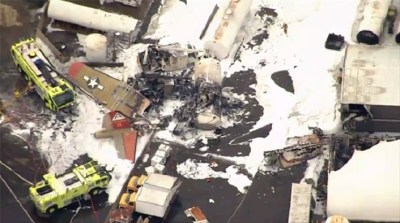Remember the Key Bridge collapse? With as eventful a year as 2025 has been, we wouldn’t blame anyone for forgetting that in March of 2024, container ship MV Dali plowed into the bridge across Baltimore Harbor, turning it into 18,000 tons of scrap metal in about four seconds, while taking the lives of six very unlucky Maryland transportation workers in the process. Now, more than a year and a half after the disaster, we finally have an idea of what caused the accident. According to the National Transportation Safety Board’s report, a loss of electrical power at just the wrong moment resulted in a cascade of failures, leaving the huge vessel without steerage. However, it was the root cause of the power outage that really got us: a wire with an incorrectly applied label.
NTSB4 Articles
Poor Maintenance Could Have Led To Fatal B-17 Crash
In October the Nine-O-Nine, a fully restored Boeing B-17G bomber owned and operated by the Collings Foundation, crashed with thirteen people on board. After landing hard and skidding into the de-icing tanks at the Bradley International Airport, all but the tail and port wing of the 74 year old WWII aircraft was destroyed. Seven lives were lost in the accident, including that of Pilot Ernest “Mac” McCauley, who was regarded as one of the most experienced B-17 pilots in the world.
 While the National Transportation Safety Board (NTSB) investigation is still ongoing and hasn’t made a final determination as to what ultimately brought down the Nine-O-Nine, enough serious maintenance issues were uncovered while examining the wreckage that the Federal Aviation Administration (FAA) has decided to rescind the Collings Foundation’s license to conduct any more paid flights on their remaining WWII aircraft. While many have spoken out in support of these “living history” flights, the FAA says they must be conducted in such a way that they don’t hinder the safety of other air traffic.
While the National Transportation Safety Board (NTSB) investigation is still ongoing and hasn’t made a final determination as to what ultimately brought down the Nine-O-Nine, enough serious maintenance issues were uncovered while examining the wreckage that the Federal Aviation Administration (FAA) has decided to rescind the Collings Foundation’s license to conduct any more paid flights on their remaining WWII aircraft. While many have spoken out in support of these “living history” flights, the FAA says they must be conducted in such a way that they don’t hinder the safety of other air traffic.
With the vast majority of the B-17’s airframe gone, the NTSB investigation has focused on the four 1,200 horsepower Wright R-1820 “Cyclone” engines recovered from the crash site. Investigators found that hastily attempted repairs to engine number 4, which is believed to have failed in-flight, were actually hindering normal operation:
Regarding engine 4, to prevent the magneto “P” leads from separating from the
magnetos, someone had attempted to rig the magneto leads in place with safety wire.Inspection and testing of engine 4 left magneto revealed the movement of the safety-wired lead caused grounding to the case, which rendered the magneto lead inoperative.
Further, all of the spark plugs in the number 3 and 4 engines were found to be fouled and had electrode gaps that were out of tolerance. From an examination of the aircraft’s maintenance records, it was also learned that an arcing and burned wire had been replaced without any investigative steps taken to find what caused the failure to begin with.
With basic maintenance tasks either not being performed or at least done incorrectly, the FAA has called into question the culture of safety at the Collings Foundation. The paper is careful not to directly accuse the Foundation or any of its staff with outright negligence, but the implication seems clear.
The loss of Nine-O-Nine hit especially close to home for Hackaday. Just a month prior to the crash we had the opportunity to tour the aircraft, and came away with a newfound respect for not only those who designed and built the iconic bomber but the brave young men who flew it. Losing such a rare and historically significant aircraft and its crew was already a tragedy, but to find that negligence may be to blame is truly inexcusable.
Saying Farewell To Another B-17 And Its Crew
The harsh reality of keeping historical airplanes airworthy and flying is that from time to time one will crash. Thus it was that on October 2nd a Boeing B-17 Flying Fortress crash-landed after technical troubles. Incidentally, this is the very same airplane which we covered only a number of days ago. Painted to look like another B-17 of WWII (Nine-o-Nine, variant B-17G-30-BO), this late-model B-17G-85-DL aircraft wasn’t finished in time to join World War II, but instead spent its 74 years being a flying museum to these amazing airplanes.
Details about the cause of the crash are still scarce, but from radio communication between the crew and tower, it’s understood the B-17 was having having issues with the number 4 engine, which was seen sputtering and smoking by a witness. The airplane’s pilots tried to perform an emergency landing at Bradley International Airport, Connecticut, where it had taken off from only moments ago. Unfortunately the aircraft ran off the runway and struck a building, after which it burst into flames. The NTSB has indicated that they have dispatched a team to investigate the crash, and say that a preliminary report is likely two weeks away.
Of the thirteen people on board, seven died, with the remaining six surviving with injuries. One person on the ground was injured as well. The vintage bomber (civilian registration number N93012) has been all but completely destroyed in the fire, with only a section of the wing and tail remaining recognizable.
We feel terrible about such loss of life and hope the injured make a speedy recovery. The loss of yet another B-17 is also tough to swallow, as this leaves just ten airworthy B-17s. How long until we say farewell to this part of our history, with the final flight of a B-17, or its kin?
(Thanks to Pez for this update)
Fatalities Vs False Positives: The Lessons From The Tesla And Uber Crashes
In one bad week in March, two people were indirectly killed by automated driving systems. A Tesla vehicle drove into a barrier, killing its driver, and an Uber vehicle hit and killed a pedestrian crossing the street. The National Transportation Safety Board’s preliminary reports on both accidents came out recently, and these bring us as close as we’re going to get to a definitive view of what actually happened. What can we learn from these two crashes?
There is one outstanding factor that makes these two crashes look different on the surface: Tesla’s algorithm misidentified a lane split and actively accelerated into the barrier, while the Uber system eventually correctly identified the cyclist crossing the street and probably had time to stop, but it was disabled. You might say that if the Tesla driver died from trusting the system too much, the Uber fatality arose from trusting the system too little.
But you’d be wrong. The forward-facing radar in the Tesla should have prevented the accident by seeing the barrier and slamming on the brakes, but the Tesla algorithm places more weight on the cameras than the radar. Why? For exactly the same reason that the Uber emergency-braking system was turned off: there are “too many” false positives and the result is that far too often the cars brake needlessly under normal driving circumstances.
The crux of the self-driving at the moment is precisely figuring out when to slam on the brakes and when not. Brake too often, and the passengers are annoyed or the car gets rear-ended. Brake too infrequently, and the consequences can be worse. Indeed, this is the central problem of autonomous vehicle safety, and neither Tesla nor Uber have it figured out yet.
Continue reading “Fatalities Vs False Positives: The Lessons From The Tesla And Uber Crashes”















